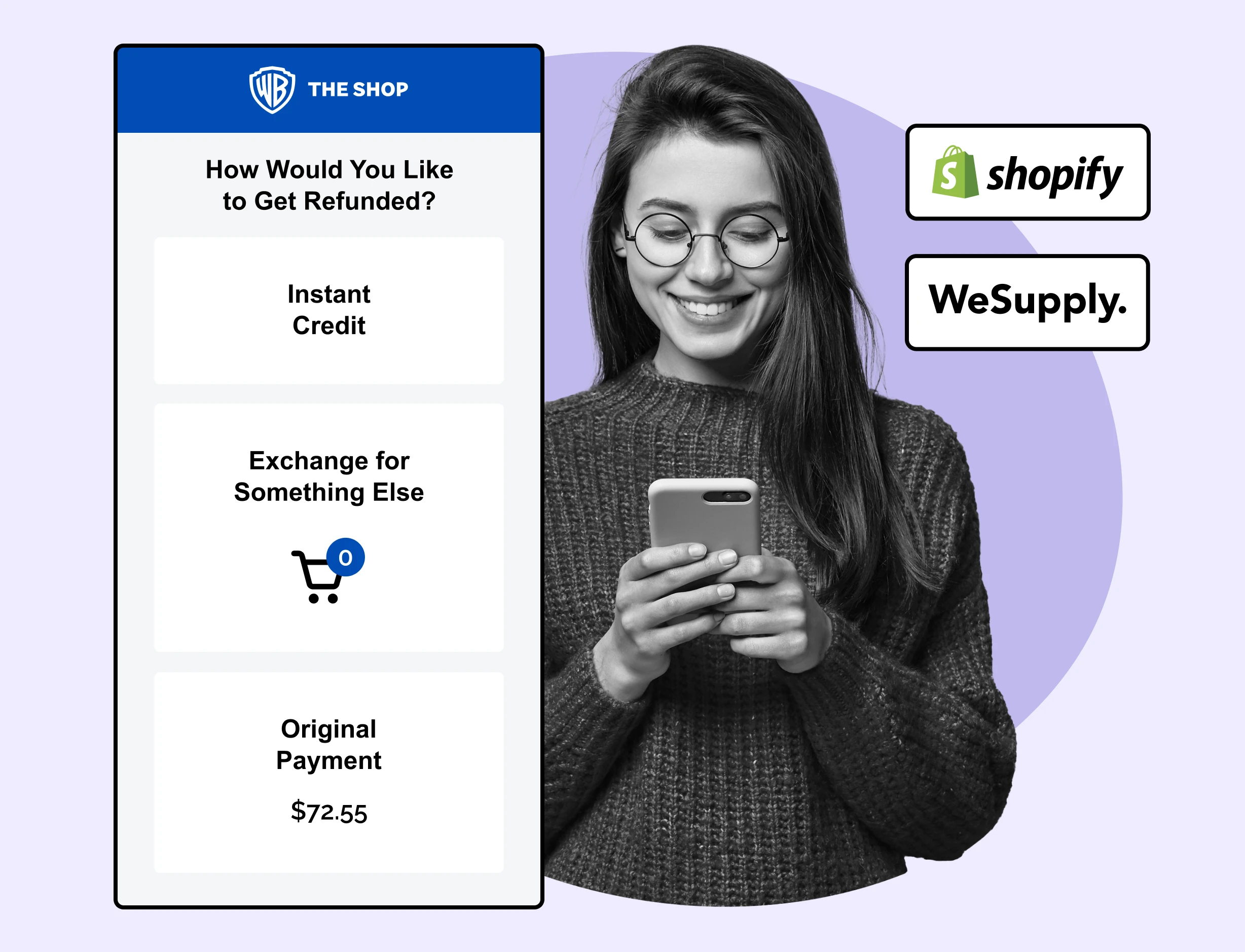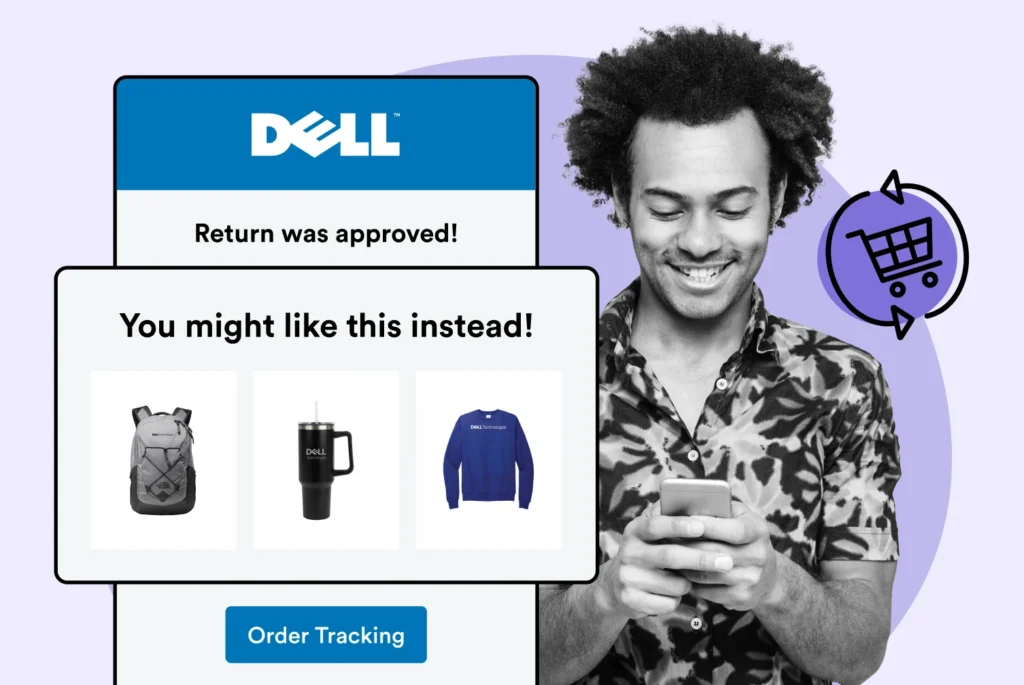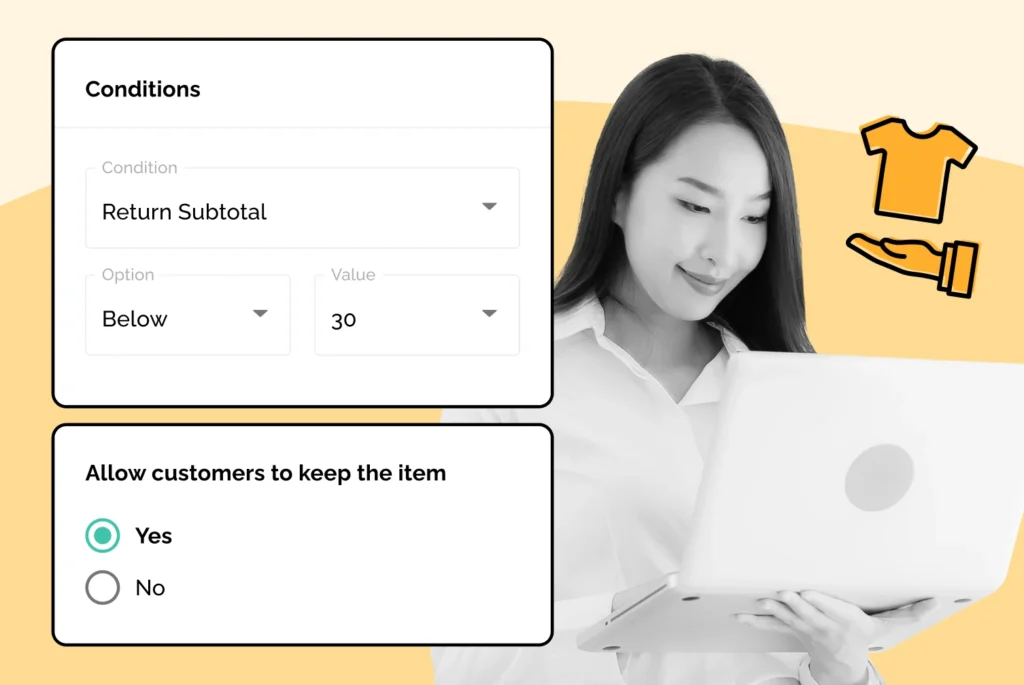
Top Ecommerce Return KPIs to Optimize Your Online Business Success
This article sheds light on effectively utilizing cross-selling, transforming a momentary setback into enduring customer value!
Boost customer experience and reduce support tickets
Realtime order and shipment tracking
Proactive order and shipping notifications
Predictive pre-purchase estimated delivery dates
Self-Serivce branded order tracking
Effortless experience delivered
Make returns profitable and delight customers
Flexibility to define any return destinations & conditions
Simplify returns for your customers and team
Incentivize exchanges over returns
Returns management made easy for your team
Understand why your customers are returning
Unify the online and the in-store experience
Hassle-free pickup experience for customers
In-Store Dashboard to keep operations streamlined
In-Store and Online orders unified
Drive foot-traffic to your stores
Boost customer experience and reduce support tickets
Realtime order and shipment tracking
Proactive order and shipping notifications
Predictive pre-purchase estimated delivery dates
Self-Serivce branded order tracking
Effortless experience delivered
Make returns profitable and delight customers
Flexibility to define any return destinations & conditions
Simplify returns for your customers and team
Incentivize exchanges over returns
Returns management made easy for your team
Understand why your customers are returning
Unify the online and the in-store experience
Hassle-free pickup experience for customers
In-Store Dashboard to keep operations streamlined
In-Store and Online orders unified
Drive foot-traffic to your stores
Find the answer to all your questions
Explore the most comon questions about WeSupply
Calculate the ROI that WeSupply can bring you
Request a no strings attached review of your current shopping experience and missed conversion opportunities
Take a step by step trip through our functionality to see how we can improve your ecommerce processes.
Read actionable articles on how to optimize your post-purchase experience and decrease support tickets
Get inspired by stories of how our customers implemented an effortless post-purchase experience
A Deep Dive into Top Companies' Order Tracking & Returns Strategy
Wondering if WeSupply is a good fit for you? Read through our use cases to see how we can help you increase conversion & improve CX!

Concerned about how “is Shopify customer returns a problem” affecting your e-commerce business? You’re not alone. Returns can indeed be a significant challenge, impacting both revenue and customer sentiment. But, it’s not all doom and gloom. This article dives into effective strategies to manage returns, enhance customer satisfaction, and even use the return process to your advantage. Discover how to tackle this complex aspect of online selling and let returns add value to your Shopify store rather than subtract from it.
Shopify return rates are an increasing challenge, with an average return rate of 20% in e-commerce, hitting retailers financially and necessitating a blend of analytics, strategy, and technology to manage them effectively.
Returns impact more than just revenue; they have a significant environmental footprint, and strategies from technology firms and retailers are emerging to address both profitability and sustainability concerns.
Effective management of returns on Shopify requires a multifaceted approach, including robust return policies, technological solutions such as AI and dedicated apps, and strategies that focus on reducing returns through improved product presentation.
WeSupply offers a streamlined solution for managing Shopify returns, boosting operational efficiency and customer satisfaction. The platform features tools like return analytics, Green Returns, automated label generation, and a branded returns portal, all designed to adapt to consumer needs and promote sustainability. With comprehensive third-party integrations and precise size guides, WeSupply minimizes returns, reducing both economic and environmental impacts, making it a prime choice for enhancing retailer customer loyalty. Download the official WeSupply Shopify App today and transform your return management process!
Shopify emerges as a powerful ally in the vibrant e-commerce landscape, enabling merchants to navigate the expansive online markets. Yet, amidst these digital waves, customer returns emerge as daunting whirlpools, threatening to engulf profits and customer satisfaction. But fear not, for mastering the art of managing returns on the Shopify platform can steer your Shopify store away from the perilous depths and towards the shores of success.
In the realm of digital commerce, customer returns are an inevitable aspect. The challenge for an online store lies not in the return itself but in the labyrinth of complexity it weaves. Legitimacy of returns, policy abuse, and the constant quest for customer satisfaction are just the tip of the iceberg. For every returned product, a question arises: How can we convert this into a triumph rather than a loss?
The solution intertwines analytics, strategy, and technology. From the nuances of managing returns to the intricate dance of exchanges and refunds, a Shopify retailer must become an alchemist, transforming the leaden weight of returns into golden opportunities for loyalty and growth. Every online purchase returned is a story to be read, a lesson to be learned, and a strategy to be honed.
Before embarking on our journey, let’s illustrate the landscape with relevant statistics. Returns in e-commerce are climbing steadily, with the average return rate for retailers reaching new heights. This statistical landscape is dotted with common issues that retailers face, from the “Fitting Roomers” who return with predictability to the “Bracketers” who buy in bulk with the intent to return. Each pattern a hurdle, each trend a beacon for the savvy Shopify store owner.
Data serves as the beacon illuminating the path for e-commerce ventures. A staggering 20% average return rate in e-commerce, with apparel retailers experiencing an even higher toll at 25%, reflects the growing challenge. The rates vary across industries, but the message is clear: returns are a significant and growing concern for any online store. These return rates are not just numbers; they are a siren call for action, heralding a need for effective ecommerce returns management strategies.
This rising tide of returns has financial repercussions—a $550 billion wake of return deliveries in 2020 in the United States alone. As the digital realm expands, so too does the propensity for customers to return products, with over three-quarters of customers returning up to 10% of their purchases. The reasons are manifold, but a leader among them is incorrect sizing, responsible for 22% of returns. For a Shopify retailer, these statistics paint a picture of an imperative: manage returns or watch your business be swept away by the current.
For store owners, the patterns of frequent returners stand prominently. “Fitting Roomers” and “Bracketers” are the specters of the retail industry, their return habits a drain on resources and a challenge to profitability. Fitting Roomers, those who make purchases with the intention of returning, and Bracketers, who buy multiple sizes and styles only to return what doesn’t fit, are more than mere customers—they are a phenomenon to be studied and understood.
Retailers must navigate the operational challenges these behaviors present, countering financial burdens and environmental concerns with strategies that are as innovative as they are effective. Technology firms like Greenlist and retail brands such as Patagonia are pioneering solutions like peer-to-peer returns and resale platforms to turn the tide on these issues.
For Shopify retailers, the message is clear: know your customer, know their habits, and be prepared to evolve.
The influence of customer returns extends beyond financial implications and leaves a significant environmental footprint. The economic burden of processing returns is hefty, but when paired with environmental repercussions such as waste and emissions, the full cost of ecommerce returns becomes starkly evident.
For a Shopify store, understanding these impacts is the first step in crafting a strategy that addresses the dual challenge of profitability and sustainability.
The cost of returns extends past the initial refund amount. The costs of processing, restocking fees, and the potential loss of revenue when items are not resalable are a significant burden for any ecommerce business. The paradox is palpable: products returned from online shopping are sometimes discarded rather than resold due to the prohibitive costs involved in the return process. Indeed, it is often more cost-effective for online retailers to discard returned goods than to inspect, repackage, and resell them.
These additional costs are a clarion call for efficiency and innovation. Startups are stepping into the breach, creating services that redirect returned goods to resellers or charities. For a Shopify retailer, these initiatives are not just good business—they’re a step towards a more responsible, sustainable approach to managing returns.
Yet, the cost isn’t solely monetary. The environmental cost—9.5 billion pounds of returned merchandise ending up in landfills annually—speaks to the need for a conscious, sustainable approach to ecommerce returns. Moreover, online returns generate around 24 million metric tons of CO2 emissions worldwide, a figure that cannot be ignored. Each Shopify return, then, is not just a transaction but a decision with far-reaching environmental implications.
The fashion industry, with its high return rate, is a particular concern, contributing significantly to these emissions and waste. Solutions like reverse logistics companies, which offer bulk shipping of box-free returns, are emerging as beacons of hope. For Shopify retailers, these solutions represent not just a way to manage returns but a commitment to a sustainable future.
WeSupply offers an innovative approach to managing returns that not only enhances business efficiency but also supports environmental sustainability. By integrating advanced features into your returns process, WeSupply helps to minimize the economic and ecological impacts of returned products.
Key features include:
Returns Analytics: Optimizes business operations, increases profits, and recovers otherwise lost revenue by identifying the most exchanged products, collecting customer feedback, and understanding the financial implications of returns and exchanges.
Green Returns: Encourages customers to keep low-cost items, reducing waste and eliminating the need for return shipping, thereby saving costs and increasing customer satisfaction.
Automatic Return Label Generation: Facilitates the easy generation of return labels, ensuring operational continuity even during staff absences.
Printerless Returns via QR Code: Enhances the customer experience by allowing returns without the need for printing, using QR codes for shipping labels which customers can simply drop off.
Intelligent Dispositions: Directs returns to recycling centers, thereby minimizing the environmental footprint and promoting sustainability.
By leveraging these features, WeSupply not only streamlines the return process but also aligns with eco-friendly practices, contributing positively to both your bottom line and the planet. Ready to revolutionize your returns? Book a demo with WeSupply today and see how we can boost your profits while protecting the planet!
As we dig deeper into the realm of returns, a variety of retailer strategies and the critical importance of comprehensive return policies come into view. A well-crafted returns strategy can be the difference between dwindling customer loyalty and a flourishing Shopify store.
For online store owners, the challenge is to find a balance that safeguards profit margins while meeting, and exceeding, customer expectations for online purchases.
Skillfully steering through the waves of returns demands a sophisticated strategy. Some retailers set their sails to discourage returns with fees and restrictions, while others chart a course that encourages them by facilitating returns at physical locations. Studies suggest that extended return deadlines can decrease return rates, as the bond between customer and product strengthens over time. On the other hand, lenient policies may increase purchases but also lead to more returns.
The strategies are varied:
Walmart and Amazon’s policies that allow customers to keep certain items instead of returning them
Marks & Spencer’s digital click-and-collect capabilities
Patagonia creating their own resale platforms, turning returns into an opportunity for sustainability and profit
For a Shopify retailer, the question is not whether to encourage or discourage returns, but how to manage them in a way that aligns with their brand values and customer expectations.
A robust return policy, conveyed transparently and effectively to customers, forms the foundational pillar of managing returns. A policy that is easily understood and accessible mitigates misunderstandings and fosters a positive relationship between the customer and the Shopify store. It should cover the timeframe for returns, the refund options available, and who bears the shipping costs, leaving no stone unturned.
For a Shopify retailer, it is crucial to tailor return policies to the unique needs of the store while maintaining simplicity. A policy littered with conditions and complications can deter customers, while one that is clear and generous can earn their loyalty. Consistency across multiple storefronts is also vital to prevent confusion and ensure a seamless shopping experience. Ultimately, the goal is to align return policies with customer expectations and inventory realities.
WeSupply empowers retailers with flexible, customizable solutions for managing returns that align with their strategic goals and customer service needs. By tailoring return policies to the unique requirements of your business, WeSupply helps you maintain control while enhancing customer satisfaction and loyalty.
Key features include:
Create custom return policies
Book a quick call with our experts to see how WeSupply can help you take control of returns by creating custom policies to handle them all easily. You get to decide how you want to handle final sale items, return window lengths, return request approvals, and more.
Shipping Fee Variability: Charge shipping fees based on the return reason, striking a balance between cost management and customer satisfaction.
Extended Holiday Return Windows: Offer extended return periods during the holiday season to accommodate increased shopping activity and enhance customer service.
Brand-Specific Return Windows: Customize return windows for different brands or vendors, providing flexibility while keeping control over return processes.
Post-Window Exchanges: Encourage continued customer engagement by allowing exchanges even after the standard return window has expired.
Utilizing WeSupply’s comprehensive return policy tools, retailers can optimize their returns strategy, adapt to consumer needs, and strengthen their brand loyalty.
In the era of digitization, technology serves as the guiding light for Shopify retailers maneuvering through the labyrinth of returns. From automation to artificial intelligence, technological solutions offer a beacon of hope, promising to streamline the returns process and improve the customer experience.
By leveraging these tools, Shopify merchants can transform the challenge of returns into an opportunity for efficiency and growth.
Artificial Intelligence (AI) pioneers this technological revolution. Platforms like True Fit leverage the power of AI to provide personalized size and fit recommendations, reducing the number of size-related returns and increasing customer confidence. With the Fashion Genome, Shopify merchants can tap into data from millions of shoppers to offer tailored recommendations, fostering brand growth and enhancing customer satisfaction.
Moreover, AI chatbots can:
Handle customer queries instantly, reducing the need for extensive customer service staffing
Address common sizing questions swiftly and efficiently
Alleviate customer concerns and diminish size-related return rates
This technology not only supports customer service teams but also represents a significant cost-saving measure for Shopify retailers.
WeSupply stands out among top Shopify return apps by offering technological solutions that streamline the return management process, enhancing both customer satisfaction and operational efficiency. This platform is ideal for retailers looking to leverage technology to improve their returns system, reduce costs, and increase customer loyalty.
Key features include:
Post-Purchase Notifications: High engagement rates with email and SMS notifications keep customers informed about their returns and offer personalized deals.
Returns Tracking: Enables customers to track their returns effortlessly, providing updates with just a few clicks.
QR Code Return Labels: Offers a printerless, hassle-free return process by using QR codes that customers can scan from their emails.
Flexible Returns Rules: Adapts return policies to suit different scenarios, avoiding one-size-fits-all limitations and enhancing customer satisfaction.
Self-Service Returns: Empowers customers by giving them control over the return process, which is a preferred method for the majority of online shoppers.
Branded Returns Portal: Creates a seamless, branded return experience that enhances customer loyalty rather than redirecting them to third-party courier pages.
Instant Credit for Exchanges: Encourages customers to choose exchanges over refunds, helping to lower return rates and increase average order values.
Extensive Integrations: Seamlessly connects with numerous third-party tools, integrating order and return data for a comprehensive and efficient system.
These features make WeSupply a comprehensive solution for Shopify retailers aiming to optimize their returns management with cutting-edge technology. Streamline your returns like never before! Download the official WeSupply Shopify App today and transform your return management process!
Merging apps with the Shopify platform can notably elevate the level of customer service. By providing features like multi-channel support, automated responses, and user-friendly interfaces, these apps empower Shopify retailers to deliver an exceptional customer experience.
In the context of returns, such integrations can streamline processes and increase customer satisfaction.
Third-party apps, including returns software, act as a propelling force for Shopify retailers, providing features such as:
Automation, which can handle customer queries, manage tickets, and assign requests to appropriate team members
Instant exchanges
Creation of custom return portals with the help of a third party app
These features further enhance the customer experience by facilitating a swift and seamless return process. By automating routine tasks, these apps free up valuable time, allowing retailers to focus on more complex issues and improving overall efficiency.
Pre-paid return shipping labels epitomize convenience in the return process, allowing customers to return items effortlessly. Once a return is approved by the Shopify store, customers receive an electronically generated label that includes all necessary details, such as sender and recipient addresses, and a barcode or QR code for scanning. This streamlined process not only simplifies returns for customers but also enables Shopify retailers to track returns efficiently, ensuring a smooth transition from customer to retailer and back to inventory if necessary.
For Shopify retailers, pre-paid return shipping labels represent a step towards a frictionless return process, improving customer satisfaction and operational efficiency.
WeSupply enhances your customer service capabilities by seamlessly integrating with a vast network of third-party apps and shipping couriers. This integration prowess allows for a smoother, more efficient management of order and returns data, significantly improving the customer experience and reducing operational costs.
Key features include:
Automated Returns Management: Automates the returns process, significantly reducing the time spent on handling returns, minimizing errors, and preventing returns fraud. It also includes features for collecting customer images and feedback to further refine the returns experience.
Incentives for Exchanges Over Returns: Encourages customers to opt for exchanges or accept store credit, enhancing customer retention and increasing the average order value.
Branded Returns Portal: Offers a fully customizable, branded returns experience with no-code customization options for tracking pages, emails, and SMS notifications, reinforcing brand loyalty and ensuring a consistent post-purchase experience.
Automatic Return Label Generation: Simplifies the return process with the capability to automatically generate return labels, ensuring that returns are handled efficiently even during peak times or staff unavailability.
With these features, WeSupply revolutionizes returns management by making it a pivotal point for building long-lasting customer relationships and loyalty. Revolutionize your returns and boost loyalty—book a WeSupply demo today!
In e-commerce, the saying “a picture is worth a thousand words” rings especially true. Here, the presentation of a product can either secure a sale or increase the probability of a return. By enhancing the visual and descriptive presentation of products, Shopify retailers can significantly reduce the number of returns, building brand trust and fostering customer loyalty in the process.
High-resolution images that offer zooming capabilities can drastically reduce returns by allowing customers to scrutinize the minutiae of products, ensuring that what they see online is what they receive in the mail. Consistency across product images and descriptions not only builds brand recognition but also sets accurate expectations, minimizing customer returns due to mismatched perceptions. For a Shopify retailer, professional and attractive product images are not just a showcase of quality but a silent salesman, convincing customers to make a purchase and stick with it.
Moreover, supplementing product descriptions with high-quality visual content, such as lifestyle images, can significantly enhance customer understanding and satisfaction, leading to more informed purchasing decisions. Precise product descriptions, influenced by customer feedback and return comments, can improve the clarity and accuracy of product information, reducing returns and increasing customer loyalty.
For e-commerce businesses, the marriage of compelling narratives and detailed visuals is key to reducing returns and enhancing the overall shopping experience.
Sizing errors are a common catalyst for returns in e-commerce, but detailed size guides and fit information can help steer customers towards the right choice. By providing customers with exact measurements and accommodating different sizing standards, Shopify retailers can cater to a diverse customer base and build trust. Customized size charts, integrated with product pages through dedicated apps from the Shopify App Store, offer a professional touch that enhances the shopping experience and reduces the likelihood of returns due to sizing issues.
Accurate sizing charts not only reduce the number of returns but also foster a deeper trust between customers and the retailer, potentially increasing the customer’s lifetime value. When customers have positive experiences with product sizing, they are more likely to advocate for the brand, leading to increased sales through word-of-mouth and influencer marketing. For Shopify stores, detailed sizing information is a powerful tool that can alleviate the practice of bracketing and ultimately reduce the volume of returns.
WeSupply leverages SKU-level returns analytics to minimize sizing errors and enhance customer satisfaction. By analyzing return data for size, color, and quality, retailers can:
Review Product Images: Enhance product images to better represent size and fit, reducing customer uncertainty when making purchases.
Increase Product Reviews: Identify products that would benefit from more customer reviews, providing future shoppers with additional insights on fit and quality.
Gather Customer Feedback: Collect and analyze customer feedback on product fit to continually refine product descriptions and sizing information.
Effectively managing return requests is vital in sustaining customer satisfaction and encouraging repeat business. By streamlining the returns management process, Shopify retailers can not only enhance profitability but also create a positive experience that may entice customers to come back for more.
Shopify’s built-in tools provide a solid foundation for streamlining the return approval process with features such as centralized returns, exchange management, and automated notifications. These features enable Shopify retailers to manage the logistics and complexities of returns with ease, from managing return fees to restocking inventory. Automation plays a pivotal role, with software solutions like WeSupply offering instant exchanges, customizable return rules, and insightful analytics on return patterns, all of which contribute to a more efficient exchange process and better handling of exchanges returns.
Self-service features within Shopify allow customers to:
Initiate returns at their convenience, reducing the need for customer service engagement and empowering customers to manage their returns
Automatically update customers via email during the return process
Refund directly once products are inspected
These tools are not just about managing returns—they’re about crafting a customer-centric returns experience that enhances loyalty and encourages future sales.
Monitoring and analyzing returns doesn’t merely serve as a reactive measure—it constitutes a proactive approach towards ongoing business enhancement. By tracking returns and accumulating data, Shopify retailers can glean insights into product quality, customer expectations, and operational workflows, leading to more informed decisions and a robust bottom line.
Returns data is a goldmine of insights, revealing patterns in customer behavior and product performance. By examining the reasons behind returns, e-commerce stores can refine product descriptions, enhance website user experience, and optimize business operations. For instance, if sizing is consistently cited as an issue, retailers can enhance product descriptions with added size charts or fit images. This not only addresses customer confusion but also demonstrates a commitment to transparency and customer satisfaction.
Furthermore, by employing automated survey systems like WeSupply, Shopify retailers can delve deeper into the reasons for returns, asking customers specific questions during the return process. This data can then inform decisions on product offerings, supplier choices, and marketing strategies. Retailers can also use return data to segment customers and tailor marketing efforts, potentially increasing customer lifetime value.
By using returns data to drive changes, Shopify retailers can improve the customer experience, reduce future returns, and ultimately increase sales.
The case of Evereve, a women’s fashion brand, offers an enlightening example of successful return management. By implementing WeSupply’s automated return process, Evereve addressed high return rates with a focus on proactivity, self-service, and flexibility. The result was a streamlined returns management system that not only saved costs but also enhanced the customer experience, allowing customers to self-manage their returns.
Evereve’s integration with WeSupply centralized all post-sale processes, improving accountability and consistency across teams. This approach led to cost savings by reducing customer service inquiries related to returns and optimizing returns processing. Additionally, the use of predictive analytics and automation helped Evereve reduce shipping costs, demonstrating the potential for technology to transform the returns landscape. For Shopify retailers, Evereve’s story underscores the importance of leveraging technology and data to manage returns effectively and reduce their overall impact on the business. Read the full case study!
Speed up returns process
Book a quick call with our experts to see how WeSupply’s self-service returns makes it super easy for your customers to return anything, anytime – without needing to submit customer support tickets or call in!
As our exploration of Shopify customer returns comes to an end, striking a balance between managing costs and ensuring customer satisfaction emerges as the guiding principle. While returns are an inherent aspect of e-commerce, Shopify retailers are equipped with the strategies, technologies, and insights needed to navigate this challenge. By embracing the lessons of returns, merchants can forge a path that not only preserves profitability but also builds enduring customer relationships.
In the intricate dance of e-commerce, returns are but a step in the choreography of customer satisfaction and business growth. From statistical insights to environmental considerations, and from technological solutions to strategic policies, handling Shopify customer returns is an art that, when mastered, can lead to a symphony of success. May this exploration serve as your compass, guiding you to a destination where returns are not a problem, but a pivotal point for continuous improvement.
WeSupply offers a comprehensive solution to Shopify’s customer returns problem, enhancing both operational efficiency and customer satisfaction. This platform integrates a variety of features that streamline returns management, adapt to consumer preferences, and support environmental sustainability.
Key Features Include:
Environmentally friendly Green Returns and recycling options.
Customizable return policies and extended holiday return windows.
Automated and printerless return label generation for easy processing.
High engagement through post-purchase notifications and a branded returns portal.
Comprehensive integrations with third-party tools and shipping couriers.
WeSupply is designed to minimize returns through detailed size guides, and its technological solutions help reduce the economic and environmental impacts of returns. It’s an ideal choice for retailers aiming to improve their return systems, reduce costs, and enhance customer loyalty. Dive into a streamlined returns process with WeSupply and turn your Shopify returns into a competitive advantage. Start your journey with WeSupply!
The average return rate for online retailers is 20%, and apparel retailers can see rates as high as 25%.
High-quality visuals can reduce return rates by enabling customers to closely examine product details and have accurate expectations, ultimately leading to more satisfying purchases.
Yes, Shopify retailers can offer pre-paid return shipping labels to simplify the return process for customers, making it more convenient for them to return items.
WeSupply is a comprehensive returns management platform that enhances operational efficiency and customer satisfaction. It features advanced analytics, automated processes, and customizable policies to streamline returns, reduce costs, and enhance the consumer experience on Shopify platforms.
Green Returns encourage customers to keep low-cost items, reducing waste and eliminating the need for return shipping. This not only saves costs but also increases customer satisfaction and contributes to environmental sustainability.
Yes, WeSupply facilitates the easy generation of return labels automatically, ensuring operational continuity even during staff absences. Customers can also benefit from printerless returns using QR codes instead of traditional labels.
Yes, WeSupply does have an official Shopify App. You can download and begin to integrate it with your Shopify store.
Yes, WeSupply has an official extension for Magento. The WeSupply x Magento integration allows for automating order tracking experiences, reducing customer inquiries, automating shipping email and SMS notifications, and providing a fully branded order tracking experience
Yes, WeSupply has an official BigCommerce App. You can integrate WeSupply with your BigCommerce store to improve your post-purchase customer experience.

Learn How To Create Successful Post Purchase Email Campaigns
Build an effective post-purchase email flow that helps you increase customer satisfaction and drive revenue growth!
Consumers seek the best deals on:

This article sheds light on effectively utilizing cross-selling, transforming a momentary setback into enduring customer value!

In the lifecycle of a product return, your business incurs additional, often-overlooked or hidden financial strains. Let’s discover them!

Are returns hurting your customer loyalty? Actually, an enhanced return experience with refunds can actually reinforce customer satisfaction!

Dive in to uncover how well-handled returns can drive repeat purchases and become a powerful catalyst for repeat business!
Cutting to the heart of direct-to-consumer success: DTC brand metrics that will navigate your strategic decisions and drive business growth!

Metrics to track, why they’re significant, and how they can guide your strategies toward minimizing returns and enhancing customer loyalty!

Let’s unpack effective strategies to influence return behavior that balance customer needs with business viability!

Let’s discover the indispensable benefits of such a dashboard, delving into the must-have features, vital metrics, and seamless integrations!

What are returnless refunds? Get ready to navigate the pros and cons of this revolutionary approach to returns!